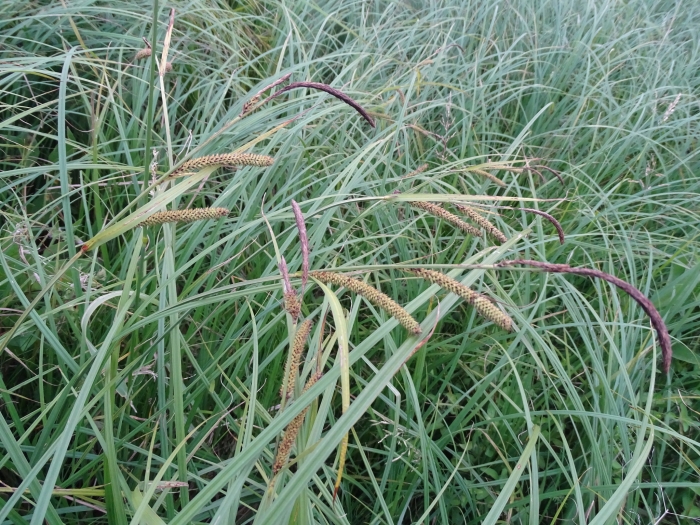Lesser Pond-Sedge
(Carex acutiformis)
Lesser Pond-Sedge (Carex acutiformis)
/
/

© Grzegorz Grzejszczak
CC BY-SA 4.0
Image By:
© Grzegorz Grzejszczak
Recorded By:
Copyright:
CC BY-SA 4.0
Copyright Notice:
Photo by: © Grzegorz Grzejszczak | License Type: CC BY-SA 4.0 | License URL: http://creativecommons.org/licenses/by-sa/4.0/ | Uploader: grzegorz_grzejszczak | Publisher: iNaturalist |
























Estimated Native Range
Summary
Carex acutiformis, commonly known as Lesser Pond-Sedge, is a perennial herbaceous plant native to a variety of wetland habitats including fen-meadows, marshes, wet woodlands, and the edges of ponds and rivers across Eurasia to South Africa. It can grow up to 59 inches tall, with long, arching leaves that are 0.2 to 0.8 inches wide. The plant forms dense clumps and produces brown flower spikes from late spring to midsummer, which are not particularly showy but add texture to the landscape.
Lesser Pond-Sedge is valued for its ability to thrive in wet conditions and is often used in naturalistic plantings, water garden edges, and as part of wetland restoration projects due to its tolerance of waterlogged soils. It provides habitat and food for wildlife, particularly for birds that use the dense foliage for cover and nesting material. In cultivation, it requires consistently moist to wet soils and can grow in full sun to part shade. While generally low-maintenance, it can spread vigorously and may need to be managed to prevent unwanted colonization of adjacent areas.CC BY-SA 4.0
Lesser Pond-Sedge is valued for its ability to thrive in wet conditions and is often used in naturalistic plantings, water garden edges, and as part of wetland restoration projects due to its tolerance of waterlogged soils. It provides habitat and food for wildlife, particularly for birds that use the dense foliage for cover and nesting material. In cultivation, it requires consistently moist to wet soils and can grow in full sun to part shade. While generally low-maintenance, it can spread vigorously and may need to be managed to prevent unwanted colonization of adjacent areas.CC BY-SA 4.0
Plant Description
- Plant Type: Grass
- Height: 1.5-2.5 feet
- Width: 1.5-2.5 feet
- Growth Rate: Moderate
- Flower Color: N/A
- Flowering Season: Spring, Summer
- Leaf Retention: Deciduous
Growth Requirements
- Sun: Full Sun, Part Shade
- Water: High, Aquatic
- Drainage: Standing, Slow
Common Uses
Border Plant, Erosion Control, Low Maintenance, Water Garden
Natural Habitat
native to a variety of wetland habitats including fen-meadows, marshes, wet woodlands, and the edges of ponds and rivers across Eurasia to South Africa
Other Names
Common Names: Nearwater sedge
Scientific Names: , Carex acutiformis, Carex acutiformis f. acutiformis, Carex acutiformis f. depauperata, Carex acutiformis f. gracilior, Carex acutiformis f. maxima, Carex acutiformis f. minor, Carex acutiformis f. spadicea, Carex acutiformis f. spadicea, Carex acutiformis f. spadicea
GBIF Accepted Name: